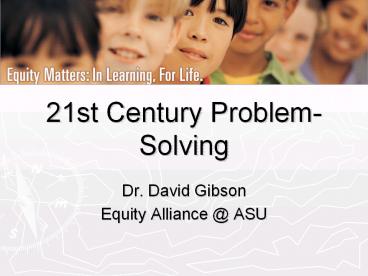21st%20Century%20Problem-Solving - PowerPoint PPT Presentation
Title:
21st%20Century%20Problem-Solving
Description:
21st Century Problem-Solving Dr. David Gibson Equity Alliance _at_ ASU Today s Agenda NEW concepts for K-12 Goals for Education 21st Century Skills Technology and ... – PowerPoint PPT presentation
Number of Views:855
Avg rating:3.0/5.0
Title: 21st%20Century%20Problem-Solving
1
21st Century Problem-Solving
- Dr. David Gibson
- Equity Alliance _at_ ASU
2
Todays Agenda
- NEW concepts for K-12 Goals for Education
- 21st Century Skills
- Technology and Engineering Concepts
- New Media Literacies
- Global Challenge Award Equity Alliance
- GCA Goals Process Success
3
Partnership for 21st C Skills
4
A Deeper Dive into 21st C Skills
- Financial, Economic, Business and Entrepreneurial
Literacy - Knowing how to make appropriate personal economic
choices - Understanding the role of the economy in society
- Using entrepreneurial skills to enhance workplace
productivity and career options
- Global Awareness
- Using 21st century skills to understand and
address global issues - Learning from and working collaboratively with
individuals representing diverse cultures,
religions and lifestyles in a spirit of mutual
respect and open dialogue in personal, work and
community contexts - Understanding other nations and cultures,
including the use of non-English languages
5
ISTEs new Framework
Make it! Say it! Find it! Solve it! Protect
it! Use it!
- Creativity and Innovation
- Communication and Collaboration
- Research and Information Fluency
- Critical Thinking, Problem Solving and Decision
Making - Digital Citizenship
- Technology Operations and Concepts
6
Engineer of 2020
- Strong analytic skills
- Practical ingenuity
- Creativity
- Communication
- Business and management
- Leadership
- High ethical standards
- Professionalism
- Dynamism, agility, resilience, and flexibility
- Lifelong learners
7
K-12 Engineering Concepts
- Systems
- Structure-behavior-function
- Emergent properties
- Control/feedback
- Processes
- Boundaries
- Subsystems
- Interactions
- Optimization
- Multiple variables
- Social constraints
- Cultural norms
- Requirements
- Physical Laws
- Trade-offs
- Resources
- Side effects
8
Engineering Design Structured Problem Solving
- Identification
- Definition
- Search
- Establish Criteria and Constraints
- Consider Alternatives
- Analysis
- Decision
- Specification
- Communication
9
New Media Literacies
- Play - the capacity to experiment with ones
surroundings as a form of problem-solving - Performance - the ability to adopt alternative
identities for the purpose of improvisation and
discovery - Simulation - the ability to interpret and
construct dynamic models of real-world processes - Appropriation - the ability to meaningfully
sample and remix media content - Multitasking - the ability to scan ones
environment and shift focus as needed to salient
details - Distributed Cognition - the ability to interact
meaningfully with tools that expand mental
capacities
- Collective Intelligence - the ability to pool
knowledge and compare notes with others toward a
common goal - Judgment - the ability to evaluate the
reliability and credibility of different
information sources - Transmedia Navigation - the ability to follow the
flow of stories and information across multiple
modalities - Networking - the ability to search for,
synthesize, and disseminate information - Negotiation - the ability to travel across
diverse communities, discerning and respecting
multiple perspectives, and grasping and following
alternative norms - Visualization - the ability to interpret and
create data representations for the purposes of
expressing ideas, finding patterns, and
identifying trends
10
How Kids Can Save the World On Their Way to
College
The Global Challenge Award
11
Global Challenge Goals
- Assist pre-college students in self-directed
learning of science, technology, engineering and
mathematics - Use game- and simulation-based guidance to
understand the complex nature of global systems - Use the tools of computational science,
simulation, and telecommunications
12
Global Challenge What Is It?Online Informal
STEM Education
High school student teams work for months to
develop a solution that addresses global warming
the future of energy.
S
S
S
S
A
A
China India Korea Japan Russia etc.
Washington Vermont California Florida Pennsylvania
etc.
13
Global Partnerships
4-person teams from the US and 50 other countries
meet and work online to solve global challenges
14
Challenge Game Elements
- Global collaboration
- Student directed
- Unstructured real world problem
- STEM learning through sims/games
- Mentor support
- Online web site support
- Web research for innovation, understanding and
ideation - Team individual learning opportunities
15
Re-Engineer Aquaculture
16
Re-Engineer a Plant Enzyme
- to increase the efficiency of plants on earth to
produce O2 from CO2
17
Create a New Process
Some students combine existing technologies in
new ways, to achieve new efficiencies.
18
Design for Global Scale-Up
Students select sites for global production and
distribution
19
World Game Missions
Explore - Experiment - Observe, record, analyze -
Build models- Compare perspectives - Lead
participate in research
20
Colleges in Our Pipeline
21
- www.equityallianceatasu.org
- www.globalchallengeaward.org































